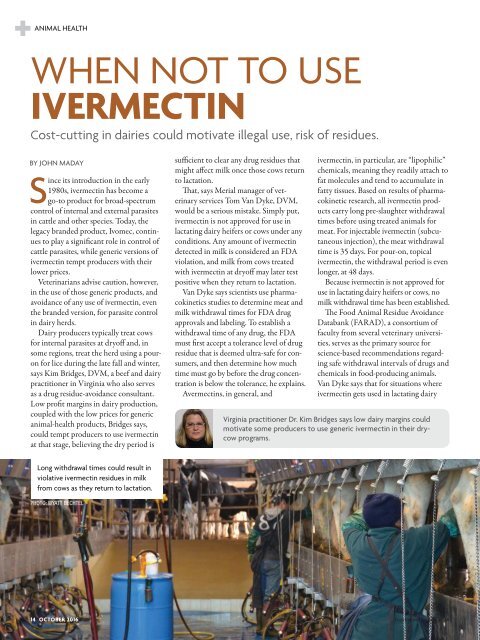Deciphering digital dermatitis
2gYEcpt
2gYEcpt
You also want an ePaper? Increase the reach of your titles
YUMPU automatically turns print PDFs into web optimized ePapers that Google loves.
ANIMAL HEALTH<br />
WHEN NOT TO USE<br />
IVERMECTIN<br />
Cost-cutting in dairies could motivate illegal use, risk of residues.<br />
BY JOHN MADAY<br />
Since its introduction in the early<br />
1980s, ivermectin has become a<br />
go-to product for broad-spectrum<br />
control of internal and external parasites<br />
in cattle and other species. Today, the<br />
legacy branded product, Ivomec, continues<br />
to play a significant role in control of<br />
cattle parasites, while generic versions of<br />
ivermectin tempt producers with their<br />
lower prices.<br />
Veterinarians advise caution, however,<br />
in the use of those generic products, and<br />
avoidance of any use of ivermectin, even<br />
the branded version, for parasite control<br />
in dairy herds.<br />
Dairy producers typically treat cows<br />
for internal parasites at dryoff and, in<br />
some regions, treat the herd using a pouron<br />
for lice during the late fall and winter,<br />
says Kim Bridges, DVM, a beef and dairy<br />
practitioner in Virginia who also serves<br />
as a drug residue-avoidance consultant.<br />
Low profit margins in dairy production,<br />
coupled with the low prices for generic<br />
animal-health products, Bridges says,<br />
could tempt producers to use ivermectin<br />
at that stage, believing the dry period is<br />
sufficient to clear any drug residues that<br />
might affect milk once those cows return<br />
to lactation.<br />
That, says Merial manager of veterinary<br />
services Tom Van Dyke, DVM,<br />
would be a serious mistake. Simply put,<br />
ivermectin is not approved for use in<br />
lactating dairy heifers or cows under any<br />
conditions. Any amount of ivermectin<br />
detected in milk is considered an FDA<br />
violation, and milk from cows treated<br />
with ivermectin at dryoff may later test<br />
positive when they return to lactation.<br />
Van Dyke says scientists use pharmacokinetics<br />
studies to determine meat and<br />
milk withdrawal times for FDA drug<br />
approvals and labeling. To establish a<br />
withdrawal time of any drug, the FDA<br />
must first accept a tolerance level of drug<br />
residue that is deemed ultra-safe for consumers,<br />
and then determine how much<br />
time must go by before the drug concentration<br />
is below the tolerance, he explains.<br />
Avermectins, in general, and<br />
ivermectin, in particular, are “lipophilic”<br />
chemicals, meaning they readily attach to<br />
fat molecules and tend to accumulate in<br />
fatty tissues. Based on results of pharmacokinetic<br />
research, all ivermectin products<br />
carry long pre-slaughter withdrawal<br />
times before using treated animals for<br />
meat. For injectable ivermectin (subcutaneous<br />
injection), the meat withdrawal<br />
time is 35 days. For pour-on, topical<br />
ivermectin, the withdrawal period is even<br />
longer, at 48 days.<br />
Because ivermectin is not approved for<br />
use in lactating dairy heifers or cows, no<br />
milk withdrawal time has been established.<br />
The Food Animal Residue Avoidance<br />
Databank (FARAD), a consortium of<br />
faculty from several veterinary universities,<br />
serves as the primary source for<br />
science-based recommendations regarding<br />
safe withdrawal intervals of drugs and<br />
chemicals in food-producing animals.<br />
Van Dyke says that for situations where<br />
ivermectin gets used in lactating dairy<br />
Virginia practitioner Dr. Kim Bridges says low dairy margins could<br />
motivate some producers to use generic ivermectin in their drycow<br />
programs.<br />
Long withdrawal times could result in<br />
violative ivermectin residues in milk<br />
from cows as they return to lactation.<br />
PHOTO: WYATT BECHTEL<br />
PHOTO: WYATT BECHTEL<br />
14 OCTOBER 2016<br />
bovinevetonline.com


